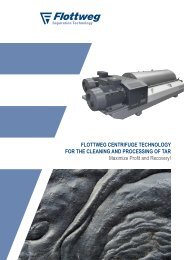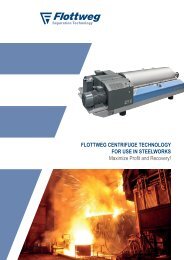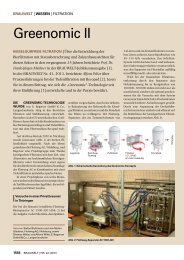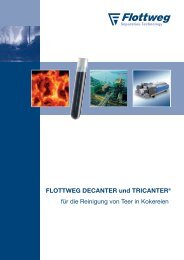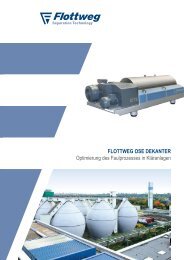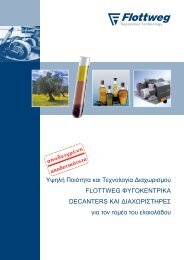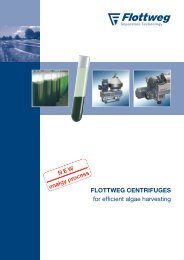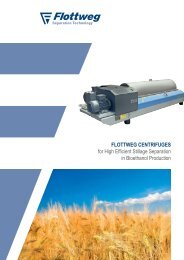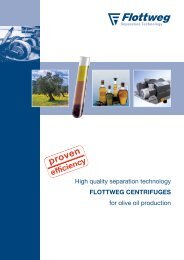INNOVATIVE SOLID BOWL CENTRIFUGE TECHNOLOGY
INNOVATIVE SOLID BOWL CENTRIFUGE TECHNOLOGY
INNOVATIVE SOLID BOWL CENTRIFUGE TECHNOLOGY
Create successful ePaper yourself
Turn your PDF publications into a flip-book with our unique Google optimized e-Paper software.
<strong>INNOVATIVE</strong> <strong>SOLID</strong> <strong>BOWL</strong><br />
<strong>CENTRIFUGE</strong> <strong>TECHNOLOGY</strong>
2<br />
Solid bowl centrifuge technology<br />
Modern centrifuges are used<br />
in technical processes for the<br />
mechanical separation of mixtures<br />
of solids and liquids.<br />
Sedimentation, centrifugation,<br />
and filtration are mechanical<br />
separation processes, in contrast<br />
to distillation, incineration<br />
and thermal drying, which are<br />
Modern centrifuges have many<br />
advantages in comparison to<br />
other separation processes<br />
such as filtration and sedimentation.<br />
Compact designs,<br />
thermal separation processes.<br />
In many processes, mechanical<br />
separation is primarily responsible<br />
for product quality,<br />
production efficiency and environmental<br />
control. Mechanical<br />
separation processes are<br />
found in practically all industrial<br />
sectors, including food, chemi-<br />
sealed construction to control<br />
odor emissions and avoid contamination<br />
of the product, ease<br />
of operation with continuous or<br />
automatic control systems,<br />
cal, pharmaceutical, biotech,<br />
mineral, and environmental.<br />
Advantages of modern centrifuges<br />
and limited replaceable operating<br />
parts such as filter media or<br />
filter aids make centrifuges advantageous<br />
to use.
Applications<br />
The following basic process<br />
operations are possible with<br />
solid bowl decanter centrifuges:<br />
• Clarification of liquids<br />
• Dewatering of sludges and<br />
suspensions<br />
• Thickening of slurries<br />
• Separation of three-phase<br />
mixtures, i.e. two immiscible<br />
liquid phases and a solid<br />
phase<br />
® = registered trademark in various countries<br />
• Classification of solids in a<br />
suspension according to particle<br />
size (wet classification)<br />
• Sorting of solids by density.<br />
To obtain optimum results, solid<br />
bowl decanter centrifuges<br />
must be custom designed to<br />
suit specific separation<br />
processes.<br />
FLOTTWEG <strong>CENTRIFUGE</strong>S<br />
can more effectively help one<br />
reach their processing goals by<br />
offering a variety of basic designs,<br />
such as the DECANTER,<br />
TRICANTER ® , SEDICANTER ®<br />
and SORTICANTER ® . Solid<br />
bowl centrifuges are used in<br />
most areas of mechanical<br />
liquid-solid separation.<br />
3
4<br />
Typical processes<br />
Foodstuffs<br />
Animal fat<br />
Blood<br />
Brewer’s yeast and trub<br />
Casein<br />
Clarified butter<br />
Coffee essence<br />
Corn stillage<br />
Drinking water treatment<br />
Fish meal<br />
Fish water<br />
Fruit juices<br />
Gelatin<br />
Lactose<br />
Meat extracts<br />
Molasses<br />
Mycelia<br />
Potato protein<br />
Potato scrapings<br />
Proteins<br />
Sorbose<br />
Soybean flour<br />
Starches<br />
Vegetable extracts<br />
Vegetable juices<br />
Vegetable oils<br />
Wine and beer<br />
Examples from more than 300 different applications<br />
Chemical products<br />
Aluminum hydroxide<br />
Barium sulfate<br />
Bauxite<br />
Bentonite<br />
Calcium carbonate<br />
Calcium fluoride<br />
Calcium sulfate<br />
Carbide sludges<br />
Caustic soda<br />
Cellulose derivatives<br />
Clay sludge<br />
Color pigments<br />
Cryolite<br />
DMT<br />
Epoxy resin<br />
Fluorescents<br />
Graphite<br />
Gypsum<br />
HDPE<br />
Iron hydroxide<br />
Iron oxide<br />
Kaolin<br />
Latex<br />
Lead oxide<br />
Lead sulfate<br />
Lignine sulfate<br />
Magnesium hydroxide<br />
Mica<br />
Mineral oil<br />
Nickel hydroxide<br />
Pharmaceutical intermediates<br />
Phosphate compounds<br />
Phosphoric acid<br />
Plastics derivatives/additives<br />
PMMA<br />
Polypropylene<br />
Polystyrene<br />
PVC<br />
Silica<br />
Silicate<br />
Sodium chloride<br />
Titanium dioxide<br />
Tricalcium phosphate<br />
Various salts<br />
Vitamins<br />
Zinc carbonate<br />
Zinc oxide<br />
Zinc sulfate<br />
Miscellaneous<br />
Coal tar cleaning<br />
Drilling mud<br />
Hide scrapings<br />
Industrial wastewater treatment<br />
Manure<br />
Municipal wastewater treatment<br />
Oil sludges<br />
Paint sludges<br />
Plastics sorting/recycling<br />
Steelworks sludges
Solid bowl centrifuges<br />
The basic principle of the solid<br />
bowl centrifuge has been<br />
known since the end of the<br />
19th century. Over the course<br />
of time, technology improvements<br />
along with the availability<br />
of high strength and corrosion<br />
resistant raw materials<br />
have allowed solid bowl de-<br />
canters to be applicable to<br />
many processes. The utilization<br />
of electronic and electromechanical<br />
measuring and<br />
control components has improved<br />
the performance and<br />
availability of the machines.<br />
The basic design of a solid<br />
bowl centrifuge is relatively<br />
simple and can be customized<br />
by Flottweg for different requirements.<br />
Of all modern industrial<br />
centrifuges, solid bowl<br />
centrifuges have the broadest<br />
range of application.<br />
5
6<br />
FLOTTWEG DECANTER <strong>CENTRIFUGE</strong>S<br />
Feed<br />
The slurry is fed through a stationary<br />
pipe into the feed zone<br />
located in the center of the<br />
scroll. The product is then accelerated<br />
circumferentially and<br />
delivered through distribution<br />
ports into the bowl.<br />
Bowl<br />
The bowl has a cylindrical/<br />
conical shape and rotates at<br />
a pre-set speed optimal for the<br />
application. The slurry rotates<br />
solids discharge<br />
FLOTTWEG DECANTER for the liquid-solid separation<br />
with gravity overflow of the liquid phase (centrate)<br />
with a different scroll design or<br />
by modifying an existing scroll.<br />
Scroll pitch and single or multiple<br />
flight configurations are important<br />
design variables.<br />
with the bowl at the operating<br />
speed and forms a concentric<br />
layer at the bowl wall. The<br />
solids contained in the slurry<br />
are deposited against the bowl<br />
wall by centrifugal force. The<br />
length of the cylindrical bowl<br />
section and the cone angle are<br />
selected to meet the specific<br />
requirements of an application.<br />
Scroll<br />
The scroll rotates at a slightly<br />
different speed than the bowl<br />
Eccentric – adjustable weir plates (patented)<br />
and conveys the deposited<br />
solids toward the conical end<br />
of the bowl. This differential<br />
speed determines the residence<br />
time of the solids in the<br />
bowl. Residence time is an important<br />
variable for the dry<br />
solids content. It can be adjusted<br />
by changing the differential<br />
speed of the scroll thus<br />
providing optimal separation.<br />
If the physical properties of the<br />
slurry change, FLOTTWEG<br />
DECANTERS can be supplied<br />
liquid discharge by gravity<br />
feed inlet
Solids discharge<br />
Settled solids are ejected<br />
through ports at the conical<br />
end of the bowl into the solids<br />
housing and fall through to the<br />
discharge chute.<br />
Materials of construction<br />
FLOTTWEG uses high-quality<br />
stainless steel for all wetted<br />
areas. Bowl and scroll castings<br />
are made from centrifugal cast<br />
high strength and corrosion<br />
resistant stainless steel.<br />
solids discharge<br />
Rotor bearing<br />
A special selection and<br />
arrangement of bearings provides<br />
long life and exceptional<br />
reliability. A central lubrication<br />
system supplies either grease<br />
or oil to bearings.<br />
Overflow weirs<br />
The clarified liquids flow to the<br />
cylindrical end of the bowl<br />
where they exit over weir<br />
plates. Easily adjustable precision<br />
weir plates allow for the<br />
FLOTTWEG DECANTER with pressurized centrate discharge<br />
precise adjustment of the pond<br />
depth in the bowl. Overflow is<br />
then collected in a centrate<br />
chamber and discharged by<br />
gravity.<br />
Impeller (skimmer)<br />
The clarified liquid can also be<br />
decanted with an impeller and<br />
discharged from the bowl under<br />
pressure. This eliminates<br />
the need for a separate centrate<br />
pump. The FLOTTWEG<br />
adjustable impeller is an engi-<br />
Adjustable impeller<br />
neering refinement that permits<br />
quick and precise adjustment<br />
of the pond depth during<br />
operation to accommodate<br />
changing conditions.<br />
liquid discharge<br />
under pressure<br />
feed inlet
8<br />
FLOTTWEG TRICANTER ®<br />
3-phase separation<br />
The FLOTTWEG TRICANTER ®<br />
enables three-phase separation,<br />
i.e. the simultaneous<br />
separation of two immiscible<br />
liquids with different densities<br />
and one solid phase, provided<br />
that the solid phase is the<br />
heaviest phase. The most important<br />
difference from a decanter<br />
is the separate discharge<br />
of the two liquid phases. The<br />
FLOTTWEG TRICANTER ®<br />
discharges the heavy liquid<br />
through an adjustable impeller<br />
under pressure and the light<br />
phase by gravity. The adjustable<br />
impeller allows adjusting<br />
the separation zone and degree<br />
of separation within the<br />
machine during operation. This<br />
optimizes purity of the liquids<br />
and may possibly eliminate<br />
downstream equipment.<br />
solids discharge liquid discharge<br />
FLOTTWEG TRICANTER ® (THREE PHASE DECANTER)<br />
Discharge of the centrate: heavy liquid phase under pressure, light phase by gravity<br />
Adjustable impeller<br />
discharge<br />
of heavy phase<br />
under pressure<br />
feed inlet
FLOTTWEG SORTICANTER ®<br />
The innovative FLOTTWEG<br />
SORTICANTER ® is designed<br />
for the separation of solids by<br />
density. The process is aided<br />
by a carrier liquid with a specific<br />
gravity that is between the<br />
densities of the two solid<br />
streams to be separated.<br />
The patented FLOTTWEG<br />
SORTICANTER ® consists of a<br />
cylindrical conical bowl with a<br />
second inner cone at the cylindrical<br />
end and a double acting<br />
FLOTTWEG SORTICANTER ® for plastic recycling<br />
flights wound in the opposite<br />
direction to those conveying<br />
sedimentated solids transfer<br />
the lighter solids across a drying<br />
zone to the exit ports. The<br />
liquid is skimmed off and discharged<br />
under pressure by an<br />
® = registered trademark in various countries<br />
scroll conforming to the inner<br />
contour of the bowl.<br />
The bowl and lagging scroll<br />
rotate at a high speed in the<br />
same direction. The solid-liquid<br />
mixture is conveyed through<br />
the centrifuge feed pipe and inlet<br />
ports in the scroll body into<br />
the bowl and accelerated to<br />
the bowl speed. Centrifugal<br />
force causes the solids which<br />
are heavier than the carrier<br />
liquid to settle against the<br />
impeller at the cylindrical end<br />
of the bowl.<br />
After an intermediate cleaning<br />
step, liquid may be recycled as<br />
carrier liquid. Carrier liquids<br />
with different densities enable<br />
bowl wall. The scroll conveys the<br />
deposited layer of heavy solids<br />
toward the conical bowl section,<br />
over the drying zone and<br />
ejects them through ports into<br />
the stationary solids housing<br />
and down the discharge chute.<br />
The solids which are lighter<br />
than the carrier liquid float and<br />
are conveyed with the liquid<br />
toward the cylindrical end of<br />
the bowl. When the floating<br />
particles have reached the<br />
second inner cone, scroll<br />
the user to shift the effective<br />
interface zone.<br />
liquid discharge<br />
under pressure<br />
solids discharge of heavy phase solids discharge of light phase<br />
feed inlet<br />
9
10<br />
FLOTTWEG SEDICANTER ®<br />
The FLOTTWEG SEDICANTER ®<br />
is used for the separation of<br />
solids from liquids when the<br />
solids form a soft but flowable<br />
sediment.<br />
The SEDICANTER ® is used in<br />
cases where the solids are too<br />
fine-grained to be processed<br />
in a normal decanter and the<br />
sediment cannot be easily discharged<br />
from the decanter due<br />
to its soft consistency. During<br />
the separation process, the<br />
FLOTTWEG SEDICANTER ®<br />
• Gastight machine design<br />
• Clean-in-place provisions<br />
available to meet pharmaceutical<br />
industry standards<br />
liquid and solids move in the<br />
same direction without having<br />
to pass through a turbulent<br />
inlet zone. The centrate is discharged<br />
through an adjustable<br />
impeller within the scroll. The<br />
sediment formed in the<br />
SEDICANTER ® , the heavy<br />
phase, is accumulated and<br />
pressed out of the bowl under<br />
an immersion disc.<br />
Applications for the<br />
SEDICANTER ® include “soft<br />
• Fluoropolymer rotor seals<br />
available for critical applications<br />
FLOTTWEG SEDICANTER ® S4E-3<br />
products” such as biomasses,<br />
yeast suspensions, protein<br />
suspensions and fermentation<br />
broths.<br />
Technical features:<br />
• Up to 10,000 x g centrifugal<br />
force possible to facilitate the<br />
separation of very fine, slowsettling<br />
solids<br />
• Uniquely designed feed distributor<br />
and bowl seal to prevent<br />
foaming in the product<br />
inlet zone<br />
solids discharge<br />
liquid discharge<br />
under pressure<br />
• Optional drives including the<br />
FLOTTWEG SIMP-DRIVE ® .<br />
feed inlet
Centrifuge cleaning<br />
Centrifuges must always be<br />
flushed clean before shutdown.<br />
Depending on the<br />
application, different cleaning<br />
systems may be incorporated<br />
into the centrifuge<br />
design.<br />
FLOTTWEG <strong>CENTRIFUGE</strong>S<br />
are designed for continuous<br />
operation and do not need to<br />
be opened for cleaning.<br />
FLOTTWEG <strong>CENTRIFUGE</strong>S for<br />
pharmaceutical, biotechnologi-<br />
Characteristic features of<br />
centrifuges to meet hygienic<br />
requirements are:<br />
• All welds are ground to meet<br />
specific sanitary finish standards.<br />
• All product-contact parts are<br />
provided with a surface finish<br />
in accordance with specified<br />
roughness values.<br />
® = registered trademark in various countries<br />
cal and food processing applications<br />
are designed with<br />
Clean-in-Place (CiP) systems.<br />
Cleaning of Centrifuges for<br />
Standard Applications<br />
For the majority of applications<br />
(e.g. sludges, separation of<br />
crystalline products), it is sufficient<br />
to flush the centrifuge<br />
before shutdown through the<br />
feed pipe to remove deposits<br />
of solids. The flushing time and<br />
the type of cleaning fluid are<br />
• Rinsing nozzles are provided<br />
for the centrifuge housing<br />
and for the interior of the<br />
scroll body.<br />
• The centrate impeller is adjustable<br />
to facilitate flushing<br />
of the bowl.<br />
• Frequency-controlled drives<br />
for CIP-cleaning at low speed.<br />
• Electropolished scroll, housing<br />
and bowl surfaces.<br />
product-dependent. In most<br />
cases, the use of a solids-free<br />
centrate will be adequate.<br />
Additional rinsing nozzles for<br />
cleaning the housing, the bowl<br />
exterior and the scroll interior<br />
can be installed if required.<br />
Cleaning of Centrifuges for<br />
Pharmaceutical, Biotechnical<br />
and Food Processing<br />
Applications<br />
FLOTTWEG designs its centrifuges<br />
for the pharmaceutical,<br />
• Special hygienic housing<br />
seals<br />
• Electrically reversible scroll<br />
rotation for enhancing cleaning<br />
during CIP cleaning.<br />
biotechnological and food<br />
processing industries to meet<br />
the highest demands for cleanliness.<br />
Requirements and<br />
specifications for design,<br />
manufacturing and testing are<br />
according to specific company<br />
standards.<br />
11
12<br />
Drives<br />
General<br />
Decanter centrifuges are subject<br />
to two conflicting basic<br />
drive requirements. On one<br />
hand, the entire rotor has to<br />
run at high speed, and on the<br />
other hand, the scroll inside the<br />
bowl has to rotate at a very low<br />
differential speed and simultaneously<br />
at a high torque relative<br />
to the bowl wall.<br />
FLOTTWEG frequency controlled<br />
electric motors or<br />
speed-adjustable hydraulic<br />
motors offer infinitely variable<br />
speed. Long start-up times<br />
help overcome a high inertia<br />
moment and avoid peak loads<br />
during the initial current phase.<br />
FLOTTWEG offers hydraulic<br />
motors or gear drives to drive<br />
the scroll depending on the<br />
application. The majority of the<br />
drive configurations offer variable<br />
differential speeds. This<br />
ensures optimum adjustment<br />
to meet individual customer<br />
requirements.<br />
Fully hydraulic drive Hybrid drive Frequency inverter drive (VFD)<br />
Fully hydraulic drive<br />
The bowl and the scroll are<br />
driven by separate hydraulic<br />
motors. A compact hydraulic<br />
aggregate with two variable<br />
pumps feeds two separate oil<br />
circuits. The volume flow of the<br />
oil determines the bowl speed<br />
and the differential speed of<br />
the scroll, whereas the oil supply<br />
pressure is directly proportional<br />
to the torque output and<br />
thus to the load. This drive per-<br />
mits the use of variably adjustable<br />
control, monitoring<br />
and analog control. The drive’s<br />
design enables independent<br />
rotation of the scroll even when<br />
the bowl is shut down.<br />
Hybrid drive<br />
In this version, a frequencycontrolled<br />
electric motor drives<br />
the bowl instead of a hydraulic<br />
motor. The hydraulic aggregate<br />
for the scroll is compact<br />
because only one oil circuit is<br />
required. Control and adjustment<br />
are the same as with the<br />
hydraulic drive. Hydraulic<br />
drives offer particular advantages<br />
for applications in mobile<br />
processing systems. Their<br />
compact design (controls, aggregate)<br />
provides for optimal<br />
utilization of floor space. Another<br />
advantage is applicability<br />
in explosion proof areas.
Gear drive with frequency<br />
inverter<br />
A frequency-controlled electric<br />
motor drives the bowl via a<br />
V-belt drive. A second parallel<br />
V-belt drive with a slightly different<br />
transmission ratio powers<br />
a cycloid planetary gear<br />
and generates the differential<br />
speed of the scroll. The differential<br />
speed can be changed<br />
and adjusted by changing<br />
V-belt pulleys.<br />
Backdrive with Dual-VFD SIMP-DRIVE ®<br />
SIMP-DRIVE ®<br />
The SIMP-DRIVE ® constitutes<br />
the new generation of the<br />
FLOTTWEG’s dual frequency<br />
inverter back drive concept.<br />
This new electric drive arrangement<br />
includes the advantages<br />
of the hydraulic and electromechanical<br />
drives. The main<br />
feature of this new concept is<br />
a multi-stage planetary gear<br />
which allows for entirely independent<br />
operation and drive of<br />
The FLOTTWEG gear drive is<br />
the most basic drive solution<br />
and is particularly suited for<br />
separation processes which do<br />
not require operating adjustment<br />
of the differential speed.<br />
Backdrive with Dual-VFD<br />
This solution is derived from<br />
the FLOTTWEG gear drive with<br />
the scroll drive having its own<br />
frequency-controlled motor.<br />
The differential speed can be<br />
the bowl and scroll (similar to<br />
a hydraulic drive)<br />
Benefits include:<br />
• High efficiency and low<br />
energy demand<br />
• A simple drive system not<br />
requiring linkage<br />
• Independent frequency<br />
inverters (VFDs) which are<br />
standard designs, simple<br />
to operate and simple to<br />
maintain<br />
separately adjusted with a preset<br />
range and controlled and<br />
monitored independently of<br />
torque. Both drive motors are<br />
powered by a FLOTTWEG frequency<br />
inverter, which is power-linked<br />
via a regenerative circuit.<br />
This drive is best suited<br />
for high differential speeds.<br />
Bowl drive<br />
Scroll drive<br />
® = registered trademark in various countries<br />
• Constant torque, high solids<br />
• Simple integration into<br />
process control systems<br />
• Smallest possible inverter<br />
size<br />
• High flexibility in the selection<br />
of the operating speed<br />
• Discharge of the bowl even at<br />
full stop<br />
• Applicable for small to medium<br />
differential speeds<br />
• Low power draw.<br />
13
14<br />
Process control system<br />
Centrifuge controls<br />
Fluctuations of the solid<br />
throughput and concentration<br />
in the centrifuge may cause a<br />
decrease in separation results,<br />
blockage or an overload of the<br />
centrifuge. To avoid problems<br />
and to fully utilize the capacity<br />
of the centrifuge, the differential<br />
speed needs to be continuously<br />
adjusted for operating<br />
conditions.<br />
FLOTTWEG offers control systems<br />
for the differential speed<br />
which are based on the following<br />
principle. Scroll torque is a<br />
measure of bowl solids load.<br />
Load and torque should be<br />
kept at an optimum value.<br />
If the torque exceeds the optimum<br />
value, the FLOTTWEG<br />
control system increases the<br />
differential speed to convey the<br />
solid faster out of the bowl until<br />
the torque decreases. Conversely,<br />
the differential speed is<br />
reduced when the torque de-<br />
creases. This automatic control<br />
process ensures optimum separation<br />
during normal operation.<br />
An integrated two-stage<br />
overload protection offers excellent<br />
control of the machine<br />
resulting from process deviations.<br />
If the increase in differential<br />
speed is not sufficient to compensate<br />
for a solids overload,<br />
the feed supply is stopped until<br />
the torque falls back below set
point. In the majority of situations,<br />
this is sufficient to remedy<br />
the overload without having<br />
to shutdown the system. If this<br />
measure is insufficient to keep<br />
the scroll torque from rising,<br />
the bowl drive is shut down<br />
when the torque reaches the<br />
second set point.<br />
As the bowl speed decreases,<br />
the torque is reduced and the<br />
machine will usually empty<br />
itself. Typically there is no need<br />
PLC decanter controller<br />
for manually removing the<br />
solids. Machines with hydraulic<br />
drive or SIMP-DRIVE ® enable<br />
solids discharge at full-torque<br />
scroll operation during the<br />
bowl shut down.<br />
FLOTTWEG provides all machines<br />
with adjustable differential<br />
speeds (hydraulic drives,<br />
dual VFDs and SIMP-DRIVE ®<br />
drives) with this control system.<br />
The range of control systems<br />
covers a basic version<br />
with a hydraulic-mechanical<br />
analog control via an electronic<br />
industrial control system to<br />
programmable logic controllers<br />
(PLC) and integration into distributive<br />
control systems (DCS).<br />
All electronic systems allow for<br />
remote control and monitoring.<br />
Programmable controls support<br />
a variety of complex links<br />
and monitoring for plant<br />
systems (e.g. CIP and automated<br />
process steps).<br />
® = registered trademark<br />
in various countries<br />
15
16<br />
Sealing systems<br />
Most sizes and models of<br />
FLOTTWEG <strong>CENTRIFUGE</strong>S<br />
are available in a variety of<br />
rotor and housing seal designs<br />
for the following operating<br />
conditions:<br />
• atmospheric<br />
• vapor-tight<br />
• gas-tight<br />
FLOTTWEG <strong>CENTRIFUGE</strong>S<br />
can also be adapted for operating<br />
in closed-loop systems.<br />
Atmospheric centrifuges are<br />
the standard version. They are<br />
used for applications where<br />
there is no harm from products<br />
or vapors released to the environment<br />
and where it is not<br />
necessary to isolate the centrifuge<br />
bowl from the surrounding<br />
atmosphere.<br />
Vapor-tight versions of<br />
FLOTTWEG centrifuges are<br />
the right choice in cases where<br />
substances emitted from the<br />
Atmospheric Vapor-tight Gas-tight<br />
Gas-tight centrifuges allow<br />
the safe operation with toxic,<br />
corrosive or flammable media<br />
by applying inert purge gas to<br />
rotor seals and by inertizing the<br />
process chamber and centrifuge<br />
housing. Slight positive<br />
or negative pressures can be<br />
maintained in the process area<br />
by regulating the purge gas<br />
supply. Special sealing elements<br />
minimize the seal gas<br />
consumption.<br />
process could pollute the environment<br />
or if contact of the<br />
product with ambient air is undesirable.<br />
Additional seals on<br />
rotor shafts and housing provide<br />
the necessary seal. Emissions<br />
can be eliminated when<br />
purge gas/air is applied to<br />
seals or the centrifuge housing<br />
is vented.
Purging with inert gas<br />
Processing of hazardous<br />
materials<br />
Processes with any risk of<br />
explosion must be controlled<br />
by using inert gas. Generally,<br />
nitrogen is used. Centrifuges<br />
and system parts used for the<br />
processing of hazardous materials<br />
have to be gastight to prevent<br />
the exit of vapors into the<br />
atmosphere as well as to avoid<br />
the entry of air into the system.<br />
Typical examples are processes<br />
in the chemical, petroleum,<br />
Rotor<br />
Seal<br />
Housing<br />
Control of centrifuges<br />
purged with inert gas is<br />
based on differential pressure<br />
monitoring.<br />
Differential pressure monitoring<br />
maintains a fixed constant<br />
overpressure in the sealing<br />
system using control valves.<br />
This ensures a small overpressure<br />
within the sealing system<br />
and the inside of the centrifuge<br />
guaranteeing protection<br />
against air leakage into the<br />
and pharmaceutical industry,<br />
processes with flammable<br />
organic solvents or oil sludge<br />
treatment processes. These<br />
centrifuges comply with<br />
ATEX 95 in Zone 1, up to<br />
temperature class T4.<br />
Purging<br />
Before starting, the entire system<br />
including the centrifuge is<br />
purged. For this purpose, large<br />
volumes of inert gas are flushed<br />
through the system until the<br />
system and product emission<br />
into the atmosphere.<br />
Processing of materials<br />
susceptible to oxidation<br />
Often the processing of beverages<br />
and food requires that<br />
products be prevented from<br />
undergoing oxidation. For this<br />
purpose the leakage of air into<br />
the centrifuge is prevented by<br />
corresponding constructive<br />
measures and positive inert<br />
oxygen is reduced below critical<br />
level with the inert gas.<br />
Purging is complete if a multiple<br />
of the system volume has<br />
passed through the machine or<br />
if an oxygen probe at the centrifuge<br />
housing shows a safe<br />
oxygen concentration.<br />
Continuous inert gas supply<br />
After successful purging and<br />
during the operation with product,<br />
sufficient inert gas is fed<br />
into the system to ensure a<br />
FLOTTWEG purge gas control unit<br />
gas pressures are maintained<br />
at the centrifuge. In many<br />
cases, carbon dioxide is used<br />
as the inert gas. A system<br />
monitoring the flow of gas is<br />
typically used.<br />
small overpressure. This prevents<br />
atmospheric air from<br />
penetrating into the system.<br />
17
18<br />
Lubrication<br />
FLOTTWEG <strong>CENTRIFUGE</strong>S<br />
can be provided with different<br />
lubrication systems. The lubrication<br />
system depends on the<br />
type of operation, for example,<br />
batch or continuous operation<br />
and the degree of automation<br />
of the entire system.<br />
Central lubrication system<br />
All main lubrication points are<br />
permanently manifolded via<br />
tubing or hoses to a central<br />
pump. The lubricant is dis-<br />
Central lubrication system<br />
(manually operated)<br />
be automatically activated.<br />
This ensures the uniform and<br />
reliable lubrication of the centrifuge.<br />
It prevents bearings<br />
from being under- or over-lubricated<br />
and rules out short-term<br />
spikes in bearing temperatures<br />
and excessive grease consumption.<br />
The grease pump is<br />
automatically controlled.<br />
For many applications, an airoperated<br />
oil droplet lubrication<br />
system is supplied.<br />
pensed proportionally through<br />
a special piston distributor. The<br />
scroll bearings are permanently<br />
sealed and lubricated, but can<br />
also be re-greased manually.<br />
Automatic grease lubrication<br />
Automatic oil droplet<br />
lubrication system<br />
The fully automatic oil-air lubrication<br />
system ensures optimal<br />
lubrication with oil droplets<br />
transported via air to the bearings.<br />
Optimum lubrication is<br />
achieved at high speeds, with<br />
low oil consumption and no<br />
loss in performance. Monitoring<br />
of the oil and air pressure<br />
guarantees high operational<br />
safety. Pneumatic designs are<br />
Automatic grease<br />
lubrication<br />
In contrast to the manual<br />
central lubrication system,<br />
the greasing system can<br />
Oil droplet lubrication system<br />
available for utilization in<br />
explosion-proof areas.<br />
They are suited for Zone 1 up to<br />
temperature class T4 according<br />
to ATEX 95. This system does<br />
not require oil recirculation or<br />
treatment.
Wear protection<br />
FLOTTWEG offers a wide<br />
range of wear protection to<br />
meet the requirements of the<br />
many different applications in<br />
which centrifuges are installed:<br />
Illustration of replaceable wear protection elements<br />
[1] Welded hard facing or spray<br />
coating<br />
[2] Ceramic<br />
[3] Tungsten carbide tiles,<br />
brazed or bolted<br />
[4] Chill castings<br />
[5] Plastic liners<br />
In order to minimize maintenance<br />
costs for applications<br />
involving highly abrasive products,<br />
all wear protection elements,<br />
except welded hard<br />
facings or spray coatings, are<br />
field-replaceable.<br />
19
20<br />
Centrifuge monitoring<br />
Vibration monitoring<br />
(standard)<br />
Vibration sensors transmit acceleration<br />
signals to an analyzer<br />
that sounds an alarm or trips<br />
the centrifuge upon reaching<br />
the full limit value.<br />
Temperature Monitoring<br />
(optional)<br />
Bearing temperatures are constantly<br />
remote-monitored in<br />
Flottweg centrifuges by means<br />
of resistance thermometers.<br />
Upon exceeding pre-set<br />
Shock Pulse Measurement<br />
(SPM) (optional)<br />
The roller bearings in the centrifuge<br />
are monitored continuously<br />
using an SPM system.<br />
Shock-impulse sensors are<br />
installed at each bearing and<br />
connected to a central alarm.<br />
temperature limits, the centrifuge<br />
alarms or shuts down.<br />
This preventive measure safeguards<br />
against bearing failure<br />
or machine damage.<br />
Pressure waves (stock impulses)<br />
emitted by damaged or worn<br />
bearings are picked up by the<br />
sensor and converted into an<br />
electrical signal An alarm is<br />
triggered if the signals from the<br />
sensor exceed a set limit more<br />
than once every 10 seconds.
Customer service<br />
Customer service is our<br />
strength<br />
Application-based project<br />
planning, high-quality manufacturing<br />
and professional<br />
after-sales service are prerequisites<br />
for customer satisfaction.<br />
Experienced and reliable<br />
service engineers from our<br />
customer service department<br />
are ready to respond quickly<br />
to reduce down time. The<br />
FLOTTWEG service group is<br />
also available to perform<br />
The Flottweg mobile test units.<br />
Service on call 365 days a year.<br />
preventive maintenance.<br />
FLOTTWEG services<br />
include:<br />
• Competent advice on<br />
separation processes<br />
• Pilot tests on-site or at the<br />
Flottweg laboratory and test<br />
center<br />
• Selection and specification<br />
of equipment<br />
• Customer-tailored automation/control<br />
systems and<br />
process integration<br />
• Design and construction of<br />
complete process systems<br />
• Installation, commissioning,<br />
maintenance, repair and<br />
spare parts service worldwide.<br />
FLOTTWEG products are<br />
designed and manufactured<br />
in GERMANY!<br />
Service hotline<br />
ISO certification<br />
FLOTTWEG is ISO 9001<br />
certified and manufactures its<br />
products in compliance with<br />
all current technical standards.<br />
Telephone<br />
+49 / 8741 301-321<br />
+49 / 180 5035135<br />
Telefax<br />
+49 / 8741 301-404<br />
21
22<br />
DECANTER<br />
Solid bowl centrifuges<br />
Product lines and models<br />
Z23-3<br />
Z23-4<br />
Z32-3<br />
Z32-4<br />
Z4E-3<br />
Z4E-4<br />
Z5E-4<br />
Z6E-2<br />
Z6E-3<br />
Z6E-4<br />
Z73-4<br />
Z92-3<br />
Z92-4<br />
Centrifugal force x g*<br />
4630<br />
3890<br />
4470<br />
3620<br />
4150<br />
4150<br />
3620<br />
3550<br />
3550<br />
3550<br />
3170<br />
2600<br />
2600<br />
* dependent on temperature<br />
and density of the slurry
TRICANTER ®<br />
SORTICANTER ®<br />
SEDICANTER ®<br />
PRODECANTER ®<br />
® = registered trademark in various countries<br />
Z23-3<br />
Z23-4<br />
Z32-3<br />
Z4E-3<br />
Z4E-4<br />
Z6E-3<br />
Z6E-4<br />
K4D-4<br />
K6E-4<br />
1680<br />
K6EF-4 2160<br />
S3E<br />
S4E<br />
S6E<br />
Centrifugal force x g*<br />
4630<br />
3890<br />
4470<br />
Z32-4 3620<br />
Z5E-4<br />
4150<br />
4150<br />
3620<br />
3550<br />
3550<br />
2880<br />
10000<br />
6500<br />
5000<br />
* dependent on temperature<br />
and density of the slurry<br />
23
Representative:<br />
FLOTTWEG subsidiaries around the world<br />
Australia<br />
Flottweg Australian<br />
Representative Office<br />
90 A Pacific Highway<br />
Roseville, NSW 2069 Sydney<br />
AUSTRALIA<br />
Telephone +61/2-94102255<br />
Telefax +61/2-94101466<br />
flottwegsydney@ozemail.com.au<br />
China<br />
Flottweg Separation Technology<br />
(Shanghai) Co. Ltd.<br />
No. 516, Chunzhong Road<br />
Xinzhuang Industrial Zone<br />
Shanghai 201108<br />
P. R. CHINA<br />
Telephone +86/21-544 20775<br />
Telefax +86/21-544 21653<br />
flottweg@online.sh.cn<br />
CIS/Russia<br />
Flottweg AG<br />
Kutusowskij Prospekt<br />
7/4 korpus 1, Office 192-193<br />
121248 Moskau<br />
CIS/RUSSIA<br />
Telephone +7/095 9748 128<br />
Telefax +7/095 9748 129<br />
flottweg.moskau@flottweg.com<br />
France<br />
Flottweg France SAS<br />
Technoparc-Espace Media<br />
3 rue Gustave Eiffel<br />
78306 Poissy Cedex<br />
FRANCE<br />
Telephone +33/1-3922-4044<br />
Telefax +33/1-3922-6453<br />
france@flottweg.fr<br />
Germany<br />
Flottweg AG<br />
Vertriebs- und Service-Center<br />
Büro Nord-Ost<br />
Handelsplatz 2<br />
04319 Leipzig<br />
GERMANY<br />
Telephone +49/341 86898-0<br />
Telefax +49/341 86898-40<br />
leipzig@flottweg.com<br />
Flottweg AG<br />
Vertriebs- und Service-Center<br />
Büro Nord-West<br />
Rösrather Straße 265<br />
51107 Köln<br />
GERMANY<br />
Telephone +49/221 299917-20<br />
Telefax +49/221 299917-30<br />
koeln@flottweg.com<br />
Italy<br />
Veronesi Separatori SPA<br />
Via Don Minzoni, 1<br />
40050 Villanova di Castenaso<br />
Bologna<br />
ITALY<br />
Telephone +39/051 6054511<br />
Telefax +39/051 6053183<br />
info@veronesi.separatori.com<br />
Mexico<br />
Flottweg Mexico S.A. de C.V.<br />
German Centre Office N° 6-4-14,<br />
Av. Santa Fe 170<br />
Col. Lomas de Santa Fe<br />
01210 Mexico, D.F.<br />
MEXICO<br />
Telephone +52/55-9172 9310<br />
Telefax +52/55-9172 9311<br />
juan.gaviria@flottweg.com<br />
Poland<br />
Flottweg Polska<br />
ul. Pelplinska 8b<br />
01-683 Warszawa<br />
POLAND<br />
Telephone +48/22-732 2230<br />
Telefax +48/22-751 4791<br />
FlottwegPoland@flottweg.com<br />
USA/Kanada<br />
Flottweg Separation Technology, Inc.<br />
10700 Toebben Drive<br />
Independence, KY41051<br />
USA<br />
Telephone +1/859 448-2300<br />
Telefax +1/859 448-2333<br />
sales@flottweg.net<br />
For more than 50 FLOTTWEG<br />
representatives worldwide see<br />
our homepage:<br />
http://www.flottweg.com/<br />
contact/service/addresses<br />
PR – 0004 I – 10 5 05 / 09



